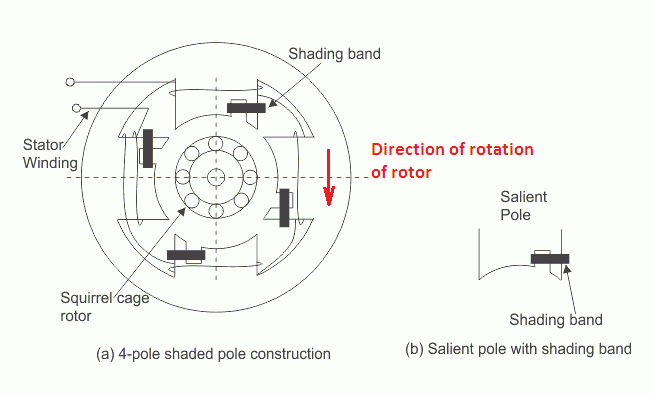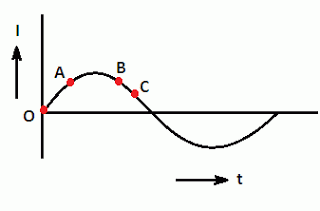A shaded pole motor is constructed with salient poles in the stator. Each pole has its exciting coil. A 1/3rd portion of each pole core is surrounded by a strap of copper forming a closed loop called the shading coil. The rotor is a usual squirrel cage type. The common form of these motors has only one winding, with no capacitor or starting windings making them economical and reliable.

The Squirrel Cage type rotor which is used in single-phase induction motors normally is also used in shaded pole motors. The rotor bars have a 60-degree skew to obtain an optimum starting torque and for limiting the torque dip during the run-up. The air-gap length between the stator and rotor is in the order of 0.25 to 0.5 mm.
Because their starting torque is low, they are best suited to driving fans or other loads that are easily started. They may have multiple taps in the winding, to provide variable speed and power by the selection of one tap at a time, as in ceiling fans. Moreover, they are compatible with TRIAC-based variable-speed fan regulators.
Working Principle of Shaded Pole Motor
The working principle of shaded pole motor is simple when the single-phase AC supply is connected to the stator winding, the main winding carries alternating current and produces magnetic flux in the stator coil. The same magnetic flux is cut by the copper shaded band.
Due to this, the EMF will be induced in the copper band. This EMF circulates the current and this current produces its own magnetic flux in the shading coil. The flux in the shading coil opposes the main stator flux. It causes a slight magnetic imbalance and generates a rotating magnetic field.
In simple words, due to the shading coil, a rotating magnetic field is generated. The direction of rotation is from the unshaded side to the shaded (ring) side of the pole. Since the phase angle between the shaded and unshaded sections is small, shaded-pole motors produce only a small starting torque relative to torque at full speed.
The direction of rotation of the shaded pole motor depends upon the position of the shading coil i.e. which half of the pole is wrapped with the shading coil. Therefore, the direction of rotation cannot be reversed unless the machine is constructed so that the shading coil can be shifted to another half of the pole.
Operation of Shaded Pole Motor

- During the portion OA (shown in above the Figure) of the alternating-current cycle, the flux begins to increase and an EMF is induced in the shading coil. This flux induces voltage and hence current in the copper ring, and by Lenz’s law, the direction of the current is such that it opposes the flux entering the coil. Hence, in the beginning, the greater portion of flux passes through the unshaded side of each pole.
- During the portion AB of the alternating-current cycle, the flux has reached almost maximum value and is not changing. Consequently, the flux distribution across the pole is uniform since no current is flowing in the shading coil.
- As the flux decreases (portion BC of the alternating-current cycle) the current induced in the shading coil now tends to prevent the flux linking with the shading coil from decreasing and hence the greater portion of flux passes through the shaded side of each pole.
Thus the flux reaches its maximum value first at the shaded side of the pole and later reaches its maximum on the unshaded side of the pole. This gives a motion of flux across the pole face in the direction of the arrow (in the direction of rotation of the rotor) as shown in the figure above.
Under the influence of this flux, small starting torque is produced. As soon as this torque starts to revolve the rotor, additional torque is produced for running because of the single-phase induction motor action. The shaded pole motor accelerates to a speed slightly below synchronous speed and runs as a single-phase motor.
Characteristics of Shaded Pole Motor
- A shaded pole induction motor produces a very small starting torque about 50% of full load torque.
- The efficiency of the shaded pole motor is low because of continuous power loss in the shading coil. It is around 26%. And also it operates on a very low power factor. So the motor becomes very inefficient for a higher power rating design. Therefore, these motors are made for only low power ratings typically 1/20 HP.
- The motor’s stall current is only slightly higher than the running current, so there is a low risk of severe overheating or tripping the circuit protection if the motor is stalled for some reason.
Advantages of Shaded Pole Motor
- It is very simple in construction. Due to its very simple construction, it is very reliable, robust and cheap.
- It is maintenance-free and easy to rewind.
- Its starting current is very low.
Disadvantages of Shaded Pole Motor
- Shaded pole motors have very low starting torque therefore, they are not suitable for high-starting torque applications.
- Reversing is not possible in these motors.
- The operating power factor is very low.
- They have very low efficiency due to continuous power loss in the shading ring.
Thanks for reading about the shaded pole motor working principle & construction.